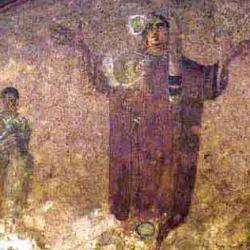We stand, we kneel, we sit, we stand, we kneel. The postures of liturgy write “upon the bodies of those who perform it frequently a habit of acting as an unworthy recipient of a prevenient gift” (Paul Griffiths, Decreation, 232).
By developing the habits that the liturgy impresses on us, we become “agents whose bodies and words are conformed to the truth that [we] are simultaneously capable of receiving the divine gift, and utterly unworthy to receive it.” This isn’t the result of “trying or learning to feel unworthy-and-worthy” nor do “worshipers knowingly perform liturgically before a mirror lined with your own eyes.” That would be an accommodation to the modern obsession with the inner theater, the concept that the inner theater makes our actions sincere.
Rather, we simply say what the liturgy teaches us to say. We do what the liturgy leads us to do. And by doing and saying over and over again, we develop habits. We become “the kind of person who does and says these things” (233).
We are trained, Griffiths says, in “radical gratitude.” The liturgy trains us as recipients, as “being one who who has received” and received gratefully (234). The liturgy doesn’t leave any corner of life untouched by its habituation. What Griffiths calls “the liturgy’s imperialistic omnivorousness” involves “a complete embrace of those who undertake it.” We die and rise n baptism, having received a “renaming, reclothing, the gift of something radically new” (234-5). Other liturgical acts “depict and endlessly repeat the subsumption of the individual into, first, the community, and then, second, the LORD.”
Griffiths means this quite literally: “The individual’s language is overtaken and framed by the language of the canon of Scripture: he is written into its margins as an ornament to the illustrated capitals of its pages. And the individual’s very physical life is shown to him to be given its meaning by his membership in the communion of saints, a body of people extending far in time and space beyond what he can directly sense.”
The liturgy “constantly signals that there is nothing external to it, nothing belonging to the individual that cannot be taken p into it, and nothing anywhere that will not, finally, be embraced by it.” Even the inner theater “is gradually transformed by participation in the liturgy from a private spectacle into an iteration of a public drama. It becomes an instance of the liturgy that claims it” (235).














